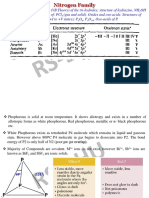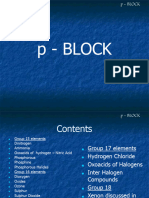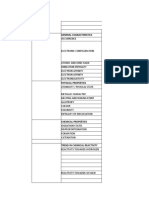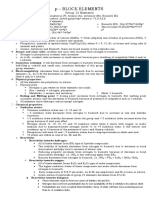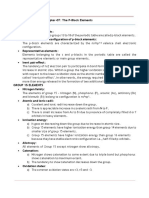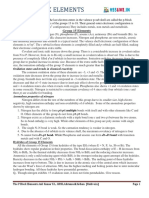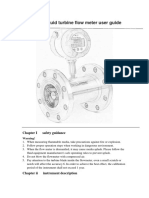7.the P-Block Elements - Group 15 Elements: Group 15 Includes Nitrogen, Phosphorus, Arsenic, Antimony and Bismuth
7.the P-Block Elements - Group 15 Elements: Group 15 Includes Nitrogen, Phosphorus, Arsenic, Antimony and Bismuth
Uploaded by
tayaCopyright:
Available Formats
7.the P-Block Elements - Group 15 Elements: Group 15 Includes Nitrogen, Phosphorus, Arsenic, Antimony and Bismuth
7.the P-Block Elements - Group 15 Elements: Group 15 Includes Nitrogen, Phosphorus, Arsenic, Antimony and Bismuth
Uploaded by
tayaOriginal Description:
Original Title
Copyright
Available Formats
Share this document
Did you find this document useful?
Is this content inappropriate?
Copyright:
Available Formats
7.the P-Block Elements - Group 15 Elements: Group 15 Includes Nitrogen, Phosphorus, Arsenic, Antimony and Bismuth
7.the P-Block Elements - Group 15 Elements: Group 15 Includes Nitrogen, Phosphorus, Arsenic, Antimony and Bismuth
Uploaded by
tayaCopyright:
Available Formats
7.
The p- Block Elements Group 15 elements
Group 15 Elements
Group 15 includes nitrogen, phosphorus, arsenic, antimony and bismuth.
N
non metal
P
As
Sb
Bi
non metal
metalloid
metalloid
metal
[He]2S22p3
[Ne]3S233p3
[Ar]3d104s24p3
[Kr]4d105s25p3
[Xe]4f145d106s2
6p3
Electronic configurationns2 np3
Atomic radii
Ionisation enthalpy
Electronegativity
Oxidation state -3, +3, +5
1. There is a considerable increase
in covalent radius from N to P.
However, from As to Bi only a small
increase in covalent radius is
observed.
2.The ionisation enthalpy of the gp
15 elements is much greater than
that of gp 14 elements
3. The ionisation enthalpy of the gp
15 elements is greater than that of
gp 16 elements
4. The tendency to exhibit 3
oxidation state decreases down the
group
5. The stability of +5 oxidation
state decreases and that of +3
state increases down the group (or)
BiCl3 is more stable than BiCl5. (or)
Pentavalent Bismuth is a good
oxidizing agent.
6. Metallic character increases
down the group.
This is due to the presence of completely
filled d and/or f orbitals in heavier
members
7. State reason for the anomalous
properties of nitrogen. (or) How
does first member of group15 differ
from the rest?
8. N2 is inert. (or) N2 is less reactive
at room temp (or) P is more
reactive than
N2.
(1) small size (2) high electronegativity,
(3) high ionisation enthalpy (4) nonavailability of d orbitals (5) form p -p
multiple bonds
N form p -p multiple bonds, high
bond enthalpy of NN bond, hence inert.
P does not form p p bonds. P-P single
bond is weak, hence reactive.
[Type text]
Because of the extra stable half-filled p
orbitals electronic configuration and
smaller size .
Because of the extra stable half-filled p
orbitals electronic configuration
Due to increase in size and metallic
character
Due to inert pair effect, +3 oxidation
state of Bi is more stable.
due to decrease in ionisation enthalpy
and increase in atomic size.
Page 1
7.The p- Block Elements Group 15 elements
9. N shows catenation properties
less than P
NN single bond is weaker than the PP
single bond because of its small size and
high interelectronic repulsion of the nonbonding electrons( lp-lp repulsion).
10.Dinitrogen exists as diatomic gas
(N2), Phosphorous as P4 solid.
12. N exhibits +5 oxidation state, it
does not form pentahalide(or)
N does not form NCl5 or NF5
N has small size, high electronegativity,
form p -p multiple bonds (form NN
bond), hence diatomic.
Due to small size, N2 molecules are held
by weak van der waals force, hence exist
as gas.
P has large size, low electronegativity,
does not form p -p multiple bonds, it
form P-P single bond, hence tetraatomic.
Due to large size, P4 molecules are held
by strong van der waals force, hence
exist as solid.
Nitrogen due to the absence of d orbitals
in its valence shell, cannot form d p
bond hence its maximum covalency is
4,whereas Phosphorous due to the
presence of d orbitals, it can form d
p bond
N due to the absence of d orbitals in its
valence shell , it cannot expand its
covalence beyond 4
13. Write the disproportionation
reaction of HNO2 and H3PO3
3HNO2 HNO3 + H2O + 2NO
4H3PO3 3H3PO4 + PH3
11. Why does R3P = O exist but R3N
= O does not exist
Hydrides of Group 15 [EH3] where E = N, P, As, Sb or Bi.
NH3
Basic character
Order of basic strength: NH3 > PH3 > AsH3 > SbH3 >
BiH3
PH3
Thermal stability Order of thermal stability: NH3 > PH3 > AsH3 >
SbH3 > BiH3.
AsH3
Reducing
Order of reducing character: NH3 < PH3 <AsH3 < SbH3 <
property
BiH3.
SbH3
BiH3
14. NH3 has high b.pt. than PH3 and
then the b.pt. increases down the
group[ from PH3 to BiH3]
[Type text]
NH3 has high b.pt. than PH3 because it
form intermolecular hydrogen bond.
B.pt increases from PH3 to BiH3 because
as size increases, van der waals force
Page 2
7.The p- Block Elements Group 15 elements
15. PH3 has lower b.pt than NH3.
16. NH3 form hydrogen bond but PH3
does not.
17. NH3 is highly soluble in water
whereas other hydrides of gp 15 is
insoluble in water.
18. NH3 act as lewis base. (or) Gp 15
hydrides act as lewis base
19.NH3 is a good complexing agent
(ligand)
20. The HNH bond angle is higher
than HPH, HAsH and HSbH angles.
21. Thermal stability decreases
from NH3 to BiH3
[NH3 > PH3 >
AsH3 > SbH3 > BiH3]
22. Reducing character increases
from NH3 to BiH3 [NH3 < PH3 <AsH3 <
SbH3 < BiH3].
23. BiH3 is the strongest reducing
agent amongst all the gp 15
hydrides
24. Basic strength order decreases
in the order NH3 > PH3 > AsH3 >
SbH3 > BiH3
(or) NH3 is more basic than PH3
(or) NH3 has a higher proton affinity
than PH3
25. Why are pentahalides more
covalent than trihalides? (or) Which
is more covalent, SbCl5 or SbCl3?
26. In what way can it be proved
that PH3 is basic in nature?
[Type text]
increases.
NH3 has high b.pt. than PH3 because it
form intermolecular hydrogen bond. no
hydrogen bond in PH3.
Due to small size and high
electronegativity, N-H bond is polar, NH 3
form H-bonding.
P has less electronegativity, P-H bond is
not polar and PH3 does not form Hbonding.
NH3 form hydrogen bond with water.
Other hydrides do not form H-bond with
water.
N can donate its lone pair hence act as
lewis base
NH3 is a lewis base, it can donate its lone
pair to metal ions to form complex
compounds.
N has small size and high
electronegativity, bond pairs are closer
to N, bp-bp repel more, hence bond
angle is higher for NH3.[as
electronegativity of central atom s,
bond angle s]
Size of central atom s, E-H bond length
s, their bond dissociation enthalpy s
and hence thermal stability s
Size of central atom s, E-H bond length
s, their bond dissociation enthalpy s,
reducing character s (ability to donate
hydrogen s)
Bi large size, least bond dissociation
enthalpy.
of Bi-H bond
N has small size and high
electronegativity, lone pair is available
for donation.[e- density is maximum on
N],NH3 more basic.
P has large size and low
electronegativity, lone pair electrons are
diffused, less basic.
Higher the positive oxidation state of
central atom, more will be its polarizing
power, increases the covalent character
of bond.
PH3 can donate its lone pair, hence act
as lewis base
PH3 reacts with acid, HI to form PH4I
PH3 + HI PH4I
Page 3
7.The p- Block Elements Group 15 elements
27. Bond angle in PH4+ is higher
than that in PH3. Why?
28. Why does NO2 dimerise?
29. What is the covalence of
nitrogen in N2O5 ?
30. Nitric oxide become brown when
released in air.Give reason
31. N form a large no. of oxides
32. Conc HNO3 can be transported in
Al containers.
33.HNO3 turns yellow on exposure
to sunlight.
34.White Phosphorous is more
reactive than red P4 .
Both are sp3 hybridised. In PH4+, P has 4
bond pair of e-, tetrahedral shape with
bond angle 109.50. In PH3, P has 3 bond
pair and 1 lone pair. Due to lp-bp
repulsion, bond angle is reduced.
NO2 contains odd number of valence
electrons. It behaves as a typical odd
molecule. On dimerisation, it is
converted to stable N2O4 molecule with
even number of electrons.
Covalence of nitrogen in N2O5 is 4
NO has unpaired e- and hence very
reactive. It readily combines with O2 of
the air to form NO2 which has brown
colour.
2NO + O2 2NO2
N form p -p multiple bonds with
oxygen due to its small size and high
electronegativity.
This is due to the formation of thin
protective layer of metal oxide on the
surface, which prevent further reaction
The presence of NO2 in the HNO3 gives it
yellow colour.
2HNO3 4NO2 + O2 +2H2O
White P is reactive due to angular strain
600 in discrete P4 molecule.
Red P is polymeric chain of P4
tetrahedra.
35. Hypophosphorous acid [H3PO2]
is a strong reducing agent than
H3PO3
36. What is the basicity of H3PO4?
H3PO2 contain two P-H bonds whereas
H3PO3 contain only one P-H bond.
[Reducing property is due to P-H bond]
Basicity-3. It is a tribasic acid because it
has 3 P-OH bond [ionisable]
37. What happens when H3PO3 is
heated?
H3PO3 disproportionates to give H3PO4
and PH3
4H3PO3 3H3PO4 + PH3
4 AgNO3 + 2H2O + H3PO2 4Ag +
4HNO3 + H3PO4
In solid state, PCl5 exist as tetrahedral
[PCl4]+ and octahedral [ PCl6]- i.e. PCl5
exist in solid state as [PCl4]+ [ PCl6]-
38. Give example for reducing
action of H3PO2
39. PCl5 is ionic in solid state.
[Type text]
Page 4
7.The p- Block Elements Group 15 elements
40. H3PO3 is a dibasic acid
3 P-OH bond [ionisable
41. Why does PCl3 and PCl5 fume in
moisture?
PCl3 and PCl5 hydrolyses in the presence
of moisture giving fumes of HCl.
PCl3 + 3H2O H3PO3 + 3HCl
PCl5 + 3H2O H3PO4 + 3HCl
PCl5 has a trigonal bipyramidal structure,
three equitorial P-Cl bonds are
equivalent with bond angle 1200 and
axial bond angle is 900.Due to the
repulsion between equatorial and axial
bonds, axial bond s are longer than eq,
bonds.
42. Are all the five bonds in
PCl5 molecule equivalent?
Dinitrogen N2
1. Commercial preparation - the liquefaction and fractional distillation of air
2. Laboratory preparation, dinitrogen is prepared by treating an aqueous
solution of ammonium chloride with sodium nitrite. NH 4CI+ NaNO2 N2(g) + 2H2O+
NaCl
3. It can also be obtained by
the thermal decomposition of ammonium dichromate.
4. Very pure nitrogen can be obtained by the thermal decomposition of sodium or
barium azide.
Ba(N3)2 Ba + 3N2
2NaN3 2Na + 3N2
Q. Write the reaction of thermal decomposition of sodium azide .
Thermal decomposition of sodium azide gives N2 gas. 2NaN3 2Na + 3N2
Properties
Habers Process
N2 combines with O2 only at very high temperature (at about 2000 K) to form nitric
oxide, NO.
Ammonia NH3
NH3 is formed in air by the decay of nitrogenous organic matter e.g., urea.
NH2 CONH2 + 2H2O ( NH4 )2CO3 2NH3 + H2O + CO2
Small scale preparation: 2NH4Cl + Ca(OH)2 2NH3 + 2H2O + CaCl2
(NH 4)2 SO4 + 2NaOH 2NH3 + 2H2O + Na2SO4
[Type text]
Page 5
7.The p- Block Elements Group 15 elements
Q. Explain the manufacture of NH3 [large scale preparation]
(or) Mention the conditions required to maximise the yield of ammonia.
Habers process. N2(g) + 3H2(g) 2NH3(g);
fH = 46.1 kJ mol1
In accordance with Le Chateliers principle, high pressure and low temperature
favour the formation of NH3. The optimum conditions are a
(1) pressure 200 atm (2). Temperature 700 K (3)Catalyst such as iron oxide [or
Fe] (4) K2O and Al2O3 [or molybdenum ]as promoter.
Properties
NH3- trigonal pyramidal.
Q. How does NH3 react with FeCl3 and ZnSO4 .
ZnSO4 + 2NH4OH Zn(OH)2 + ( NH4)2 SO4
( white ppt )
FeCl3 + NH4OH Fe2O3 .xH2O + NH4Cl
( brown ppt )
Q. How does NH3 react with Cu2+ (or) How do you detect the presence of
Cu2+.
NH3 react with Cu2+ by donating its lone pair to form deep blue coloured complex.
Cu2+ + 4NH3 [Cu(NH3)4]2+
(blue)
(deep blue)
Q. How does NH3 react with AgCl.
AgCl + 2NH3 [Ag ( NH3 )2]Cl
(white ppt)
(colourless)
Nitric acid [HNO3].
Laboratory preparation:
NaNO3 + H2SO4 NaHSO4 + HNO3
Q. Explain Ostwald process for the manufacture of HNO 3
On a large scale it is prepared mainly by Ostwalds process.
Catalytic oxidation of NH3 by atmospheric oxygen.
Nitric oxide thus formed combines with oxygen giving NO 2.
2NO + O2 2NO2
Nitrogen dioxide so formed, dissolves in water to give HNO 3.
3NO2 + H2O 2HNO3 + NO
Properties
Reaction of HNO3 with metals HNO3 is an oxidizing agent.
3Cu + 8 HNO3(dilute) 3Cu(NO3)2 + 2NO + 4H2O
Cu + 4HNO3(conc.) Cu(NO3)2 + 2NO2 + 2H2O
4Zn + 10HNO3(dilute) 4 Zn (NO3)2 + 5H2O + N2O
Zn + 4HNO3(conc.) Zn (NO3)2 + 2H2O + 2NO2
Metals like Cr, Al do not dissolve in concentrated nitric acid because of the
formation of a passive film of oxide on the surface.
[Type text]
Page 6
7.The p- Block Elements Group 15 elements
Reaction of HNO3 with metals
I2 + 10HNO3 2HIO3 + 10NO2 + 4H2O
C + 4HNO3 CO2 + 2H2O + 4NO2
S8 + 48HNO3 8H2SO4 + 48NO2 + 16H2O
P4 + 20HNO3 4H3PO4 + 20NO2 + 4H2O
Q. Explain the Chemistry of brown ring test.
It is used to detect the presence of nitrate ion. Fe 2+ reduce nitrates to nitric oxide,
which reacts with Fe2+ to form a brown coloured complex.
The test is carried out by adding dilute FeSO 4 solution to nitrate solution, and then
carefully adding conc. sulphuric acid along the sides of the test tube. A brown ring
at the interface between the solution and sulphuric acid layers indicates the
presence of nitrate ion in solution.
NO3- + 3Fe2+ + 4H+ NO + 3Fe3+ + 2H2O
[Fe (H2O)6 ]2+ + NO [Fe (H2O)5 (NO)]2++ H2O
(brown)
Phosphorous
Allotropic forms - white, red and black.
Q. Write the difference in properties of white and red phosphorous
White P
Red P
i)a translucent white waxy solid , garlic
i)iron grey luster, odourless
smell
ii)poisonous
ii)non- poisonous
iii)insoluble in water but soluble in CS 2
iii)insoluble in water and CS2
iv)Glows in dark
iv)does not glow in the dark
v)Less stable, more reactive than red P
v)red phosphorus is much less reactive
due to angular strain 600 in P4
than white phosphorus (polymeric chain
molecule(discrete tetrahedra)
of tetrahedra)
Q. Why is white P is generally stored under water?
Its ignition temp. is very low and therefore it readily catches fire in air to give dense
white fumes of P4O10.
P 4 + 5O2 P4O10
Q. What happens when white phosphorus is heated with concentrated
NaOH solution in an inert atmosphere of CO2 ? [lab prep of PH3]
It form PH3
P4 + 3NaOH + 3H2O PH3 + 3NaH2PO2 ( sodium
hypophosphite )
[Type text]
Page 7
7.The p- Block Elements Group 15 elements
Phosphine -Preparation.
Ca3P2 + 6H2O 3Ca(OH)2 + 2PH3
Ca3P2 + 6HCl 3CaCl2 + 2PH3
Properties
3CuSO4 + 2PH3 Cu3 P2 + 3H2SO4
3HgCl2 + 2PH3 Hg3P2 + 6HCl
Phosphine is weakly basic , react with acids
PH 3 + HBr PH4 Br
PCl3
1. Preparation
P4 + 6Cl2 4PCl3
P4 + 8SOCl2 4PCl3 + 4SO2 + 2S2Cl2
PCl5
1. Preparation
P4 + 10Cl2 4PCl5
P4 + 10SO2Cl2 4PCl5 + 10SO2
2. Properties
PCl3 + 3H2O H3PO3 + 3HCl
PCl3 and PCl5 fume in moisture due to
HCl
3CH3COOH + PCl3 3CH3COCl + H3PO3
3C2H5OH + PCl3 3C2H5Cl + H3PO3
2. Properties
PCl5 + H2O POCl3 + 2HCl
POCl3 + 3H2O H3PO4 + 3HCl
C2H5OH + PCl5 C2H5Cl + POCl3 + HCl
CH3COOH + PCl5 CH3COCl +
POCl3 +HCl
2Ag + PCl5 2AgCl + PCl3
Sn + 2PCl5 SnCl4 + 2PCl3
pyramidal shape
Trigonal bipyramidal [liquid & gaseous
phase]
In the solid state, PCl5exists as an ionic
solid, [PCl4]+[PCl6]- in which [PCl4]+ is
tetrahedral and [PCl6] - octahedral.
Q. What happens when PCl5 is heated?
Q. Write a balanced equation for the hydrolytic reaction of PCl 5 in heavy
water(D2O).
PCl5 + D2O POCl3+ 2DCl
POCl3 + 3D2O D3PO4 + 3DCl
[Type text]
Page 8
7.The p- Block Elements Group 15 elements
[Type text]
Page 9
You might also like
- TAD722GEDocument250 pagesTAD722GEFedor GrigorievNo ratings yet
- Dermatomyositis NCPDocument3 pagesDermatomyositis NCPMakki MarcosNo ratings yet
- 15TH Group ElementsDocument8 pages15TH Group ElementsredoxreactionsNo ratings yet
- Chapter 7 The P Block ElementsDocument14 pagesChapter 7 The P Block ElementsNAVEEN BUNKARNo ratings yet
- NCERT Solutions Class 12 Chemistry Chapter 7 P Block ElementsDocument17 pagesNCERT Solutions Class 12 Chemistry Chapter 7 P Block ElementsVidyakulNo ratings yet
- 7.p Block Elements NewDocument22 pages7.p Block Elements NewMehak GandhiNo ratings yet
- Notes On P-Block ElementsDocument14 pagesNotes On P-Block ElementscurioeNo ratings yet
- UPDATED PBlock ElementsDocument100 pagesUPDATED PBlock ElementsAarohi SharmaNo ratings yet
- P BlockDocument23 pagesP BlockMohd HassanNo ratings yet
- The P-Block Elements (Summary)Document49 pagesThe P-Block Elements (Summary)nickan876No ratings yet
- Chapter 7 11Document34 pagesChapter 7 11Ritik KumarNo ratings yet
- P Block ElementsDocument35 pagesP Block ElementsParth ShuklaNo ratings yet
- 7 P Block Elements 1.pptxDocument54 pages7 P Block Elements 1.pptxAmita RajputNo ratings yet
- 10+2 Chem P-Block ElementsDocument44 pages10+2 Chem P-Block ElementsArjun PasrichaNo ratings yet
- Some More QuestionsDocument18 pagesSome More QuestionsGauravNo ratings yet
- Chem Quiz 3Document13 pagesChem Quiz 3Gaurav ShekharNo ratings yet
- CBSE Class 12 Chem Notes Question Block Elements PDFDocument28 pagesCBSE Class 12 Chem Notes Question Block Elements PDFThiru98No ratings yet
- P Block Elements 01Document23 pagesP Block Elements 01Hussain AbbasNo ratings yet
- Chemistry 11th N&O FamilyDocument58 pagesChemistry 11th N&O FamilySJAIN12No ratings yet
- Element Symbol Property: (He) 2s 2p (Ne) 3s 3p (Ar) 4s 4p (KR) 5s 5p (Xe) 6s 6pDocument10 pagesElement Symbol Property: (He) 2s 2p (Ne) 3s 3p (Ar) 4s 4p (KR) 5s 5p (Xe) 6s 6pVarun BansalNo ratings yet
- Element Symbol Property: (He) 2s 2p (Ne) 3s 3p (Ar) 4s 4p (KR) 5s 5p (Xe) 6s 6pDocument22 pagesElement Symbol Property: (He) 2s 2p (Ne) 3s 3p (Ar) 4s 4p (KR) 5s 5p (Xe) 6s 6pMuskan VashistNo ratings yet
- Chemistry P Block ElementsDocument14 pagesChemistry P Block ElementsSurendra Tyagi0% (1)
- Chem 1101 - Chemistry and Periodicity of GP 15 Elements: VseprDocument16 pagesChem 1101 - Chemistry and Periodicity of GP 15 Elements: VseprNicholas OwNo ratings yet
- P-Block Element: Chemistry Practical (Term 1)Document14 pagesP-Block Element: Chemistry Practical (Term 1)Siddhant BaghelNo ratings yet
- THE P - Block Elements-Anil-Hsslive PDFDocument19 pagesTHE P - Block Elements-Anil-Hsslive PDFKochuzNo ratings yet
- Basic Concepts P-Block Class 12Document26 pagesBasic Concepts P-Block Class 12gomathi_nellaiNo ratings yet
- P Block Elements Notes For Entrance ExaminationDocument13 pagesP Block Elements Notes For Entrance ExaminationSrijan ChakrabortyNo ratings yet
- Zam P BLOCK NW 4Document212 pagesZam P BLOCK NW 4mrrsiddiquiNo ratings yet
- NitrogenDocument58 pagesNitrogenPriyansh Mishra100% (2)
- 7group VDocument22 pages7group Vglaurent487No ratings yet
- 8 P Block FullDocument17 pages8 P Block Fullaleena'No ratings yet
- Chapter 7 Chemistry Class 12_Formula_SheetDocument8 pagesChapter 7 Chemistry Class 12_Formula_SheetmayankmatrybhatiaNo ratings yet
- MTAssignmentDocument4 pagesMTAssignmentMrigank SoniNo ratings yet
- P-Block Element: Prepared By: Dr. Nirmala Kumari Kv-2, GayaDocument24 pagesP-Block Element: Prepared By: Dr. Nirmala Kumari Kv-2, GayaAwayavee DinkerNo ratings yet
- Inorganic ChemistryDocument13 pagesInorganic Chemistrybhargavthegreat123No ratings yet
- 12 Chemistry NcertSolutions Chapter 7 Exercises PDFDocument17 pages12 Chemistry NcertSolutions Chapter 7 Exercises PDFDeepak YadavNo ratings yet
- Nitrogen FamilyDocument33 pagesNitrogen FamilyArpit PatelNo ratings yet
- Che 4 Final MaterialDocument78 pagesChe 4 Final MaterialAman HashimNo ratings yet
- P BlockDocument28 pagesP BlockKamalpreet SinghNo ratings yet
- Reasoning Questions in P Block ElementsDocument15 pagesReasoning Questions in P Block ElementsAbhi WaliaNo ratings yet
- 7 P Block Elements 6d Full Chapter.pptDocument105 pages7 P Block Elements 6d Full Chapter.pptAmita RajputNo ratings yet
- P Bond Question AnswersDocument10 pagesP Bond Question Answerszkcps8zcktNo ratings yet
- Nitrogen Family Study NotesDocument61 pagesNitrogen Family Study NotesBelezza CoNo ratings yet
- NCERT Solutions Chemistry Class XIDocument28 pagesNCERT Solutions Chemistry Class XIGabriel BandaNo ratings yet
- ..-EAMCET-QR-Chemistry-Sr Chem-10.VA Group Elements - 171-175 - PDFDocument12 pages..-EAMCET-QR-Chemistry-Sr Chem-10.VA Group Elements - 171-175 - PDFPragyanshu ParadkarNo ratings yet
- CH 219 TUTORIAL 4 SOLVED BY FacilitatorDocument4 pagesCH 219 TUTORIAL 4 SOLVED BY FacilitatorClaudius MaximusNo ratings yet
- COMPARATIVE STUDY FOR P - BLOCK ELEMENTSDocument10 pagesCOMPARATIVE STUDY FOR P - BLOCK ELEMENTSvishuNo ratings yet
- P Block ElemetsDocument16 pagesP Block ElemetsAnthony KevinNo ratings yet
- Lock Roup: Chapter-1Document42 pagesLock Roup: Chapter-1Binod TharuNo ratings yet
- P Block ElementsDocument20 pagesP Block ElementsVenkatesh Venky0% (1)
- P - Block Reasoning 16, 17, 18 Very Simplified - (1) FDocument9 pagesP - Block Reasoning 16, 17, 18 Very Simplified - (1) FShazia FarheenNo ratings yet
- P-D Reasoning Questions AnswersDocument4 pagesP-D Reasoning Questions AnswersGarvit GandhiNo ratings yet
- Chapter-07: The P-Block ElementsDocument10 pagesChapter-07: The P-Block ElementsCheryl ChaudhariNo ratings yet
- CHEMISTRY OF THE REPRESENTATIVE ELEMENTS-II Mid Q & ADocument13 pagesCHEMISTRY OF THE REPRESENTATIVE ELEMENTS-II Mid Q & AAflatur SafaNo ratings yet
- Class 12 P Block SNDocument10 pagesClass 12 P Block SN09 Krishna TrivediNo ratings yet
- HSSLiVE-XII-Che-7 The P - Block Elements 2Document17 pagesHSSLiVE-XII-Che-7 The P - Block Elements 2Ranit Mukherjee0% (1)
- Boronic Acids: Preparation and Applications in Organic Synthesis, Medicine and MaterialsFrom EverandBoronic Acids: Preparation and Applications in Organic Synthesis, Medicine and MaterialsDennis G. HallNo ratings yet
- A System of Instruction in the Practical Use of the BlowpipeFrom EverandA System of Instruction in the Practical Use of the BlowpipeNo ratings yet
- Metal Catalyzed Cross-Coupling Reactions and MoreFrom EverandMetal Catalyzed Cross-Coupling Reactions and MoreArmin de MeijereNo ratings yet
- (A) Analysis and Estimation of The Coefficient of Consolidation - Raju Et Al., 1995Document7 pages(A) Analysis and Estimation of The Coefficient of Consolidation - Raju Et Al., 1995JociellNo ratings yet
- Beginning Calculus (SMN3013)Document4 pagesBeginning Calculus (SMN3013)nurul najwaNo ratings yet
- AutoFluid GuideDocument75 pagesAutoFluid GuideLazar PetkovicNo ratings yet
- Assignment 04Document8 pagesAssignment 04John MilanNo ratings yet
- Sa50 PublicationsDocument177 pagesSa50 PublicationsJacob K ThomasNo ratings yet
- Pending Indent and NON OMSDocument2 pagesPending Indent and NON OMSNani PagoluNo ratings yet
- Anticipation: Basic 3D Animation Using BlenderDocument15 pagesAnticipation: Basic 3D Animation Using BlenderAnnie VoinovaNo ratings yet
- FA-150 ManualDocument2 pagesFA-150 ManualThuy Phuong0% (1)
- Brainteasers For Investment Banking and Management Consulting InterviewsDocument7 pagesBrainteasers For Investment Banking and Management Consulting InterviewsIanNo ratings yet
- Passion ThesisDocument7 pagesPassion Thesiscgvmxrief100% (2)
- GT-Turbine Flowmeter ManualDocument16 pagesGT-Turbine Flowmeter Manualedgarcoo100% (1)
- LR Baggs Acoustic DiDocument8 pagesLR Baggs Acoustic DiSanjyNo ratings yet
- The Undermountain LVL 1Document20 pagesThe Undermountain LVL 1talikoNo ratings yet
- Pre-Foundation Geophysical Investigation of A Site For Structural Development in Oka, Nigeria - TPB38 - FERDIAN KURNIAWANDocument2 pagesPre-Foundation Geophysical Investigation of A Site For Structural Development in Oka, Nigeria - TPB38 - FERDIAN KURNIAWANFerdian KurniawanNo ratings yet
- Model Name 2MCW0530A1AA 2MWW0530A1AA: Non-Hydrophilic AluminiumDocument1 pageModel Name 2MCW0530A1AA 2MWW0530A1AA: Non-Hydrophilic AluminiumFranciscoNo ratings yet
- Tunnel Design Basis Report PDFDocument25 pagesTunnel Design Basis Report PDFgayathry50% (2)
- Speak Word: Marilyn Hickey & Sarah BowlingDocument35 pagesSpeak Word: Marilyn Hickey & Sarah BowlingTimothy Jones75% (4)
- Industries Class 8 QADocument3 pagesIndustries Class 8 QAtwolivegreensNo ratings yet
- Tubular & Non Tubular AWS D1.1Document56 pagesTubular & Non Tubular AWS D1.1Rico Ferdian100% (1)
- Leitner Report 2023 ENDocument75 pagesLeitner Report 2023 ENcarlo-maria.franceschiNo ratings yet
- Lista Noviembre16Document10 pagesLista Noviembre16Avraham ZentliNo ratings yet
- Ay 2020-2021Document39 pagesAy 2020-2021NarasimhaReddy PangaNo ratings yet
- Q and A On Vent Settings PandemicDocument6 pagesQ and A On Vent Settings PandemicChris Martin100% (1)
- Low Cost' Three Phase To Single Phase Matrix ConverterDocument6 pagesLow Cost' Three Phase To Single Phase Matrix ConverterRaghu RamNo ratings yet
- XALC's Expanded PF2 Character Sheet - Form FillableDocument36 pagesXALC's Expanded PF2 Character Sheet - Form Fillablevavire8359No ratings yet
- Mini ProjectDocument16 pagesMini Projectkunalbele0No ratings yet
- SITXMGT001 Student LogbookDocument34 pagesSITXMGT001 Student LogbookRamesh Adhikari100% (1)
- Capital Gain Compensation Recd From Central GovernmentDocument45 pagesCapital Gain Compensation Recd From Central Governmentphani raja kumarNo ratings yet




































